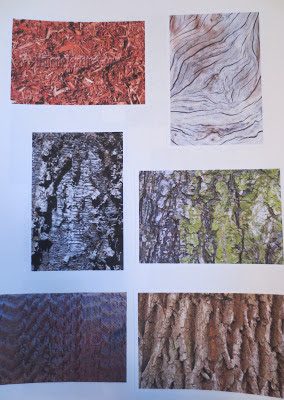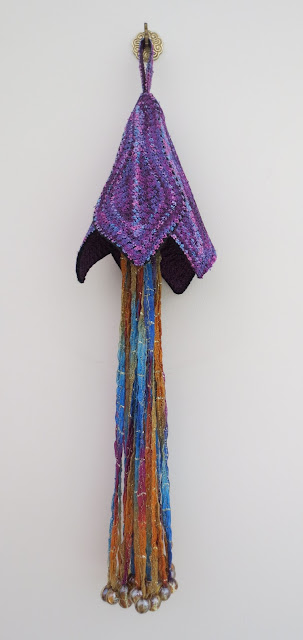Texture Resources
Soft and Fluffy (above)
Smooth and Shiny (above & aubergine below)
Soft and Smooth (above)
Coarse and Rough (above)
Sharp and Spiky (above)
Word Bank to describe texture...
silky, smooth, fluffy, spiky, rough, rumpled, feathery, coarse, crunchy, creased, knobbled, bushy, cratered, dusty, dry, grooved, fuzzy, bouncy, glassy, puffy, moist, woolly...
I'm sure I'll think of more to add as time goes by!
I'm sure I'll think of more to add as time goes by!
Bridget Riley and Visual Texture
Examples of Bridget Riley's work that are 2D but create a feeling of being 3D. The movement of the lines creates this optical illusion. I appreciated the technique use in these paintings, but couldn't say that I really liked them.
Using cable stitch to recreate Bridget Riley's 1963 painting 'Fall'
This was quite difficult to recreate and I wasn't really happy with the final result. If sewing this gain, I would 'bunch' the lines up in the curves more, with the thread closer together. This would help in creating the optical illusion required. Also, I would try a thicker thread. I'm afraid that I didn't really like the art work enough to have another try!
Experiments with Stitching Textures
Leaves in Autumn (front)
It was quite easy to choose colours for the leaves, but quite difficult to create the crunchy, rough textures. I tried using different width threads (weights 30 & 40), but wasn't overly impressed with the final result.
Autumn leaves (back)
When I turned over the leaf picture to trim the threads, I found that I preferred the effect that the back of the sewing made! I had used a different colour thread under parts of the design and this created a 'negative' image, with black thread where the outline and veins of the leaves had been on the front of the sample.
A cactus
The texture of the cactus was easier for me to sew, as the very fine spines could be created by using a fine thread, and the fleshy green parts by using granite stitch in a thicker (weight 30) green thread.
Alium Flower Heads
I tried to create the fluffy heads of the flowers by using moss stitch in a 40 wt purple thread and the stamens of the flower heads with a 30 wt variegated green thread. I thought the moss stitch was quite effective in creating the texture of the small flowers, but looking back the the design now, wish that I had sewn more of them, to fill out the final design a little more.
Spiky Leaves on a Thistle
For this sample, I decided to use a thinner (30wt) thread and only sew the outline, in the style of Cefyn Burgess. I used a lilac thread initially to outine the shape of the leaves and then followed this with a fine silver thread. I was pleased with the final result, but thought that maybe I had relied on the colours I had used, rather than thinking about the texture.
Mark Making to create Visual Texture
The following exercises were completed using charcoal, fine black pen and black ink (applied with a sponge).
Struggling through a thorn bush, recreated with weight 8 black thread, using cable stitch. Although I haven't managed to stick to the design of the original, I liked the effect of 'struggling' that the more knotty areas made.
Crunching through frost recreated with weight 12 black thread, using cable stitch & also weight 40 thread free embroidery from the top. I thought this wasn't so successful as it looked too clumpy. Perhaps I should have used finer thread throughout and sewn less densely?
Wrapping yourself in a coccon of vine leaves, recreated with weight 40 thread, using free machine embbroidery from the top. This was quite successful, as a fine line is easy to imitate using thread.
I found that the designs with definite 'lines' were easier to recreate, and that I would need to think more carefully about how to achive thicker lines or 'patches' of stitching. I wasn't able to think of a way to recreate the wispy lines of the 'whisper of wind', despite looking at my thread collection for quite a while for inspiration!
Creating Texture with Paper and Glue
Inspiration
I liked this image, as it has quite alot of depth, an interesting texture and different colours that I would be able to pick out with thread.
Thread selection...
I chose a range of threads to use; from thick hand embroidery threads, wt 8 embroidery threads (in olive green) and wt 40 machine embroidery threads.
Tree bark picture, recreated in tissue paper and PVA glue
Mapping out the design on felt
The final design
The two layers of felt were stitched together (by hand) and then the top layer of felt was burnt away. I found that this took quite a long time, as the stitching was quite thick. I found that high and low relief areas were re-created effectively and did resemble the initial picture, although I would have liked some of the edges where the two layers were joined together to be a little 'rougher'. Perhaps I would have been able to achieve this by using slightly less stitching near the edges of the shapes for the top layer, or by using thinner thread in these areas?
































.jpg)



